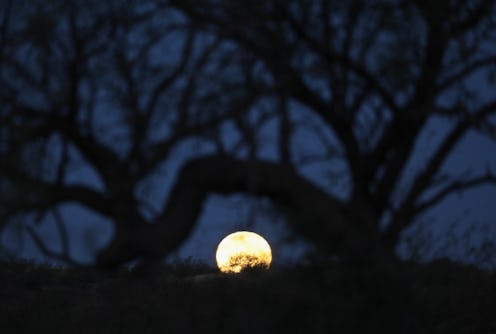
This December marks a pretty big lunar event: the first and only supermoon of 2017, also known as the Cold Moon. Just after sunrise on Dec. 4, early risers will be able to see a moon that appears larger and brighter than normal, a sight that is both unique and a little magical. But, uh, what if you miss the December supermoon? After all, it's not exactly hard to press the snooze button one too many times in the wee hours of the morning. So, when is the next supermoon in 2018? Luckily, you won't have to wait too long to get a second chance at this dreamy view.
First, though, you should probably get a better understanding of what you're going to be waiting to see. "Supermoon" is a popular term for a full or new moon that comes close enough to Earth to make it appear both larger and brighter. The moon is constantly orbiting around Earth, but it doesn't do so in a perfect circle, which means that its distance to Earth isn't always the same. When it reaches its closest point, it's referred to as the supermoon.
We aren't always able to see these supermoons. According to National Geographic, the December supermoon isn't actually the only supermoon of 2017 — it's technically the fourth supermoon of the year, but what makes it stand out is that it's the only one visible to the naked eye. The other three of the year coincided with new moons, so the lunar disk made it harder to see them. When the supermoons are totally visible, it's a special event, and fortunately, this is not the only event of its kind. The new year of 2018 will be starting off with a bang, so get your alarm clocks ready.
According to astronomers, the full moons on both Jan. 2 and Jan. 31 will also be supermoons, which is pretty rare and amazing — and gives nature multiple chances to bless us with clear skies. The supermoon that will occur on Jan. 2 has also been known as the Full Wolf Moon, the Old Moon, and the Moon After Yule. The supermoon on Jan. 31 will be the second full moon in the same month, which is referred to as a Blue Moon.
If you only plan on trying to catch one of these supermoons, you might want to make it the Blue Moon. While supermoons aren't very rare, a Blue Moon only happens about every two to three years. So, it's obviously not incredibly rare, but it's also not something that happens all the time (I bet the phrase "once in a blue moon" is making a whole lot more sense right now). Unfortunately, the name isn't literal, and the moon won't actually look blue. Color aside, this is something of a special event. According to Space.com, this will be the last supermoon of 2018 and it will coincide with a lunar eclipse.
What does this mean for us? Well, the first month of 2018 should certainly be an interesting one! Considering the fact that astrologists believe a normal full moon has some strange side effects, some believe that a supermoon intensifies those effects. Having two of them in one month could definitely change our horoscopes up a bit.
Want to see both supermoons of 2018? Although we don't yet know the best time to view them, your best bet is to set an alarm to see them right after sunrise — this is usually the time of day the moon will appear largest. If you can't even think about getting up that early, plan to look outside just before sunset, as the moon rises. And since you have two big chances to see a supermoon in January 2018, you have no excuse to miss out.